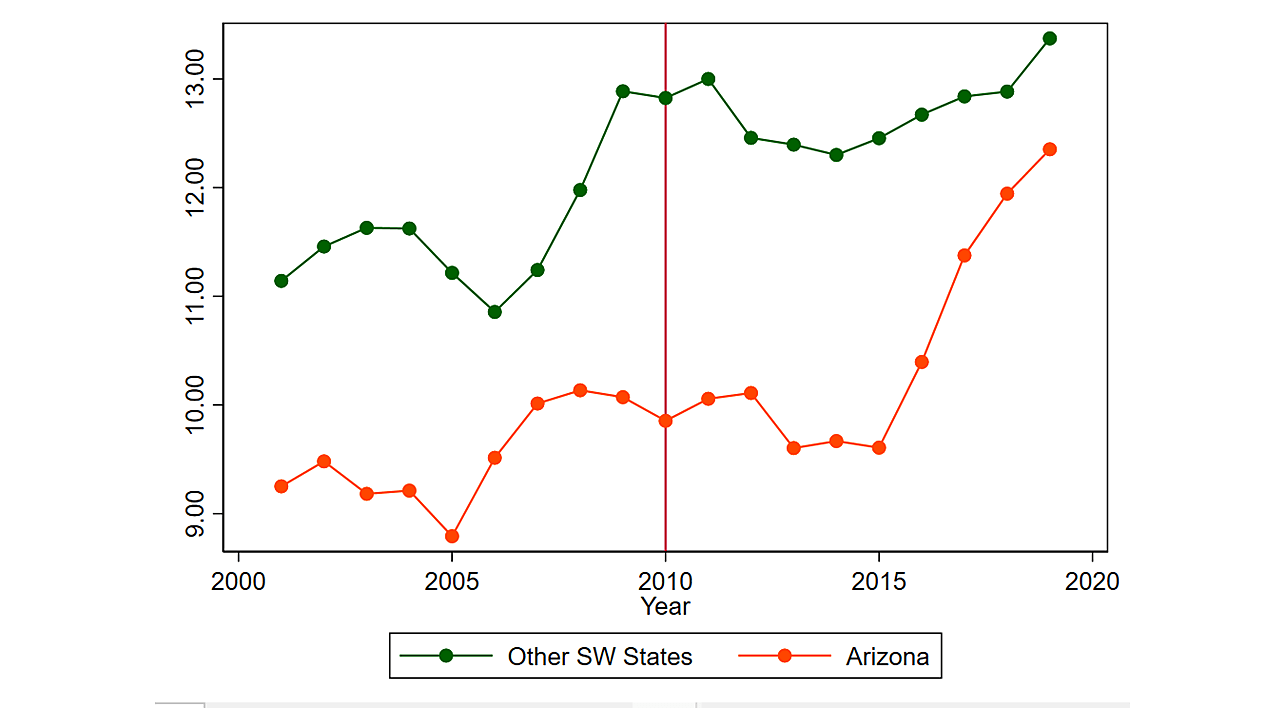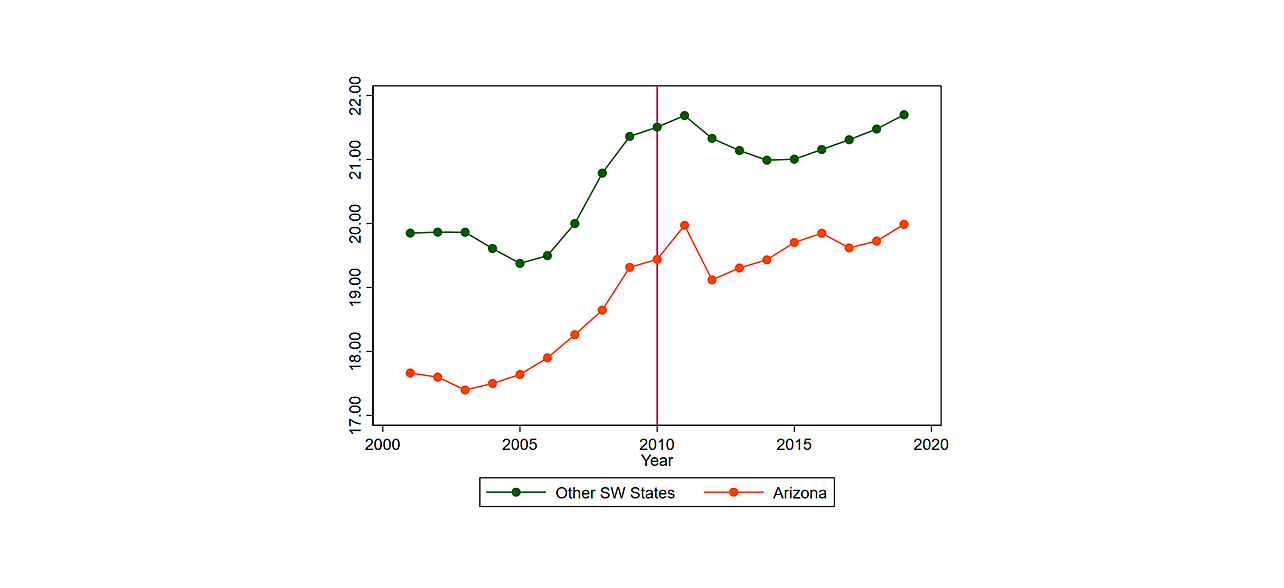National conservatives have latched onto the idea that cutting immigration will increase wages despite all of the evidence to the contrary. One of the pieces of evidence they cite most is a 2016 article in the Wall Street Journal that states that wages for construction and farm occupations in Arizona went up by 10 percent and 15 percent, respectively, in the 4 years after Arizona passed its immigration enforcement law SB1070 in 2010. Both Oren Cass and Christopher Caldwell use this data point.
The only problem is those claims about wages are not true. Wages did not rise in Arizona after the passage of SB1070. This blog post uses data from the Bureau of Labor Statistics’ Occupational Employment Statistics (OES) and different methods to investigate whether wages for construction and farm workers rose in Arizona after the passage of SB1070. In every instance, wages did not rise in Arizona after that state passed immigration enforcement laws in 2007 and 2010. Just as economic theory would predict, there was no absolute rise in wages after Arizona cracked down on illegal immigration.
Farm Wages
The mean nominal wage for all farm workers (occupational code 45–0000) in the OES rose only 4.7 percent in nominal terms, from $9.52 an hour in 2010 to $9.97 an hour in 2014. In real terms, using the personal consumption expenditures index (PCE) with a base year of 2012, wages for all farming jobs in Arizona fell over that time from $9.85 to $9.67 an hour – an almost 2 percent decline in real hourly wages. That is a lot less than the 15 percent rise that was supposed to have occurred.
Perhaps farm worker wages started rising in 2007, the year that Arizona passed a law mandating E‑Verify for all new hires in the state. That 2007 law, called the Legal Arizona Workers Act (LAWA), is often confused with the 2010 law SB1070. LAWA likely did cause a large decline in the illegal immigrant population in Arizona – about 41 percent from 2007 to 2010 according to an estimate based on the Gunadi method of calculating the illegal immigrant population. Let’s be extra generous and see how wages changed from 2007 through 2014. During that time, hourly wages for Arizona farm workers rose by 7.8 percent in nominal terms and declined 3.4 percent in real terms.
Another possibility is that farm worker wages in Arizona rose relative to farm worker wages in other states. That’s not the same as saying that Arizona farm workers got a raise, but perhaps wages there didn’t decline as much as in other Southwestern states that didn’t pass anti-immigration laws. Thus, I used a difference-in-differences approach to compare wages in Arizona with wages in the other Southwestern states of California, Colorado, Nevada, New Mexico, Texas, and Utah; before and after the passage of SB1070. There is no statistically significant difference in real hourly Arizona farm wages that occurs after the passage of SB1070 with a correlation coefficient of ‑0.005, standard errors of 0.964, and a p‑value of 0.996. Figure 1 shows real hourly farm worker wages in Arizona versus the average of the other Southwest states. Changing the treatment year to 2007 to coincide with the passage of LAWA yields similarly insignificant results but a much more negative coefficient, as can clearly be seen in Figure 1.
Figure 1
Farm Worker Wages in Arizona vs. Other Southwestern States
Farm worker wages did rise from the 2006 to 2007 period and in the 2016 to 2019 period. In the earlier period, the illegal immigrant population in Arizona rose by 26 percent. In the latter period, it rose by about 4 percent. Interestingly, farm worker wages stagnated and even declined during the exact period when Arizona’s 2007 and 2010 immigration laws were in effect. A complicating factor is that SB1070 was gutted by the Supreme Court in 2012, turning it into a zombie statute. How could SB1070, a law that was passed in 2010 and gutted in 2012, cause the real hourly wage for farm workers in Arizona to rise four years later when the illegal immigrant population was also increasing? I have not yet heard an explanation from national conservatives.
Construction Wages
The other claim is that construction wages rose by 10 percent after the passage of SB1070. The mean nominal hourly wage for all construction workers (47–0000) in the OES was essentially flat from 2010–2014. They rose by 6.7 percent from $18.78 per hour in 2010 to $20.04 per hour in 2014. In real terms, construction wages fell by 1 cent from $19.44 an hour in 2010 to $19.43 an hour in 2014. Like above, we must give the national conservatives the benefit of the doubt. Perhaps they meant to start their analysis in 2007 when Arizona mandated E‑Verify. Over that longer time, the nominal hourly construction wages rose 18.8 percent and 6.4 percent in real terms. That’s still a lot less than the 10 percent they claimed over a much shorter period.
An analysis using difference-in-differences, which is methodologically identical to that for farm workers, shows no statistically significant difference after 2010 with a correlation coefficient of 0.360, a standard error of 0.629, and a p‑value of 0.567. Figure 2 shows real hourly construction worker wages in Arizona versus the average of the other Southwest states. Changing the treatment year to 2007 to coincide with the passage of LAWA yields similarly insignificant results. No matter how you look at it, construction wages in Arizona did not increase relative to other states when that state government passed SB1070 in 2010 or LAWA in 2007.
Figure 2
Construction Worker Wages in Arizona vs. Other Southwestern States
I ran similar analyses for real hourly wages for all occupations in Arizona compared to other states in the Southwest. There was no statistically significant difference. These difference-in-differences analyses are simple and readers can perform better analyses easily enough, but I’m at the point where there seems to be little utility in going further. There just isn’t anything there. This blog post attempted to discover whether construction and farm wages rose in Arizona after SB1070 was passed, which is the claim made by Cass, Caldwell, and others. It’s time for national conservatives to do the hard work and provide evidence for their claims. No matter how you slice the evidence, Arizona’s immigration laws did not increase the wages of workers in Arizona.
Special thanks to Devin Thompson who helped with completing this blog post.


